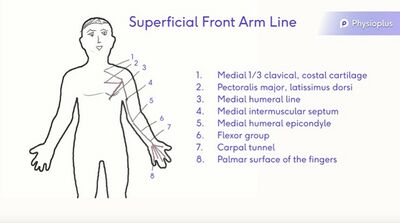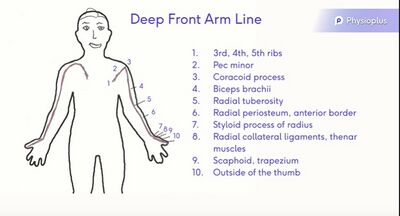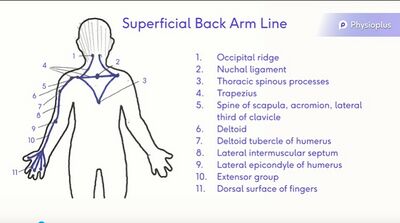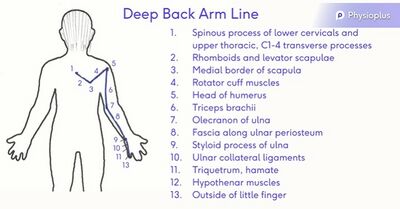Upper Extremity Myofascial Chains: Difference between revisions
No edit summary |
No edit summary |
||
| Line 8: | Line 8: | ||
In the upper limb there are four myofascial chains<ref>Wilke J, Krause F. [https://onlinelibrary.wiley.com/doi/abs/10.1002/ca.23424 Myofascial chains of the upper limb: a systematic review of anatomical studies.] Clinical Anatomy. 2019 Oct;32(7):934-40.</ref>: | In the upper limb there are four myofascial chains<ref>Wilke J, Krause F. [https://onlinelibrary.wiley.com/doi/abs/10.1002/ca.23424 Myofascial chains of the upper limb: a systematic review of anatomical studies.] Clinical Anatomy. 2019 Oct;32(7):934-40.</ref>: | ||
# Superficial front arm line | # Superficial front arm line (Figure 1) | ||
# Deep front arm line | # Deep front arm line (Figure 2) | ||
# Superficial back arm line | # Superficial back arm line (Figure 3) | ||
# Deep back arm line | # Deep back arm line (Figure 4) | ||
These are described in more detail below | These are described in more detail below | ||
== Superficial Front Arm Line == | == Superficial Front Arm Line == | ||
This line travels down the medial side of the arm.<ref name=":0">Pandya R. Upper Extremity Myofascial Chains Course. Physioplus, 2021.</ref> | |||
# [[File:Superficial Front Arm Line.jpg|thumb|400x400px|Figure 1. Superficial front arm line.]]Medial third of the clavicle, coastal cartilage | # [[File:Superficial Front Arm Line.jpg|thumb|400x400px|Figure 1. Superficial front arm line.]]Medial third of the clavicle, coastal cartilage | ||
# Pectoralis major, Lattissimus dorsi | # Pectoralis major, Lattissimus dorsi | ||
| Line 26: | Line 27: | ||
== Deep Front Arm Line == | == Deep Front Arm Line == | ||
This line travels down the radial side of the arm. Clinical symptoms associated with this chain might include tingling / numbness on the lateral side of the thumb, which could be associated with [[Medial Epicondyle Tendinopathy|golfer's elbow]].<ref name=":0" /> | |||
# [[File:Deep Front Arm Line.jpg|thumb|400x400px|Figure 2. Deep front arm line.]]3rd, 4th and 5th ribs | # [[File:Deep Front Arm Line.jpg|thumb|400x400px|Figure 2. Deep front arm line.]]3rd, 4th and 5th ribs | ||
# Pectoralis minor | # Pectoralis minor | ||
| Line 38: | Line 40: | ||
== Superficial Back Arm Line == | == Superficial Back Arm Line == | ||
This line travels along the RADIAL side of the arm. Clinical symptoms associated with dysfunction in this line include: rounded shoulder / kyphotic spine (i.e. office workers), neck pain and headaches. Trigger points may be present in the periscapular area and along the extensor aspect of the arm. There may also be signs of carpal tunnel syndrome.<ref name=":0" /> | |||
# [[File:Superficial Back Arm Line.jpg|thumb|400x400px|Figure 3. Superficial back arm line.]]Occipital ridge | # [[File:Superficial Back Arm Line.jpg|thumb|400x400px|Figure 3. Superficial back arm line.]]Occipital ridge | ||
# Nuchal ligament | # Nuchal ligament | ||
| Line 51: | Line 54: | ||
== Deep Back Arm Line == | == Deep Back Arm Line == | ||
This line travels along the ulnar border of the arm. Patients might complain of pain on the medial border of the scapula.<ref name=":0" /> | |||
# [[File:Deep Back Arm Line (2).jpg|thumb|400x400px|Figure 4. Deep back arm line.]]Spinous process of lower cervicals and upper thoracic, C1-4 transverse processes | # [[File:Deep Back Arm Line (2).jpg|thumb|400x400px|Figure 4. Deep back arm line.]]Spinous process of lower cervicals and upper thoracic, C1-4 transverse processes | ||
# Rhomboids and levator scapula | # Rhomboids and levator scapula | ||
Revision as of 23:24, 12 September 2021
Top Contributors - Jess Bell, Carin Hunter, Kim Jackson, Lucinda hampton and Robin Tacchetti
Introduction[edit | edit source]
A myofascial chain is a line of connective tissue that runs throughout the body. There is a posterior (back) line, an anterior (front) line, a spiral line, and a lateral line. These lines help the body to move as a unit.[1]
Myofascial chains are important for functional movement, coordination and stability.[2] They can, however, also cause pain within the body and structural weakness.[3] By understanding myofascial chains, you can better understand injuries and movement limitations.[4]
In the upper limb there are four myofascial chains[5]:
- Superficial front arm line (Figure 1)
- Deep front arm line (Figure 2)
- Superficial back arm line (Figure 3)
- Deep back arm line (Figure 4)
These are described in more detail below
Superficial Front Arm Line[edit | edit source]
This line travels down the medial side of the arm.[6]
- Medial third of the clavicle, coastal cartilage
- Pectoralis major, Lattissimus dorsi
- Medial humeral line
- Medial intermuscular septum
- Medial humeral epicondyle
- Flexor group
- Carpal tunnel
- Palmar surface of the fingers
Deep Front Arm Line[edit | edit source]
This line travels down the radial side of the arm. Clinical symptoms associated with this chain might include tingling / numbness on the lateral side of the thumb, which could be associated with golfer's elbow.[6]
- 3rd, 4th and 5th ribs
- Pectoralis minor
- Coracoid process
- Biceps brachii
- Radial tuberosity
- Anterior border of radial periosteum
- Styloid process of radius
- Radial collateral ligaments and thenar muscles
- Scaphoid and trapezuim
- Outside of the thumb
Superficial Back Arm Line[edit | edit source]
This line travels along the RADIAL side of the arm. Clinical symptoms associated with dysfunction in this line include: rounded shoulder / kyphotic spine (i.e. office workers), neck pain and headaches. Trigger points may be present in the periscapular area and along the extensor aspect of the arm. There may also be signs of carpal tunnel syndrome.[6]
- Occipital ridge
- Nuchal ligament
- Thoracic spinous process
- Trapezius
- Spine of scapula, acromion, lateral third of clavicle
- Deltoid
- Deltoid tubercle of humerus
- Lateral intramuscular septum
- Lateral epicondyle of humerus
- Extensor group
- Dorsal surface of fingers
Deep Back Arm Line[edit | edit source]
This line travels along the ulnar border of the arm. Patients might complain of pain on the medial border of the scapula.[6]
- Spinous process of lower cervicals and upper thoracic, C1-4 transverse processes
- Rhomboids and levator scapula
- Medial border of scapula
- Rotator cuff muscles
- Head of humerus
- Triceps brachii
- Olecranon of ulna
- Fascia along ulnar periosteum
- Styloid process of ulna
- Ulnar collateral ligaments
- Triquetrum, hamate
- Hypothenar muscles
- Outside of little finger
Stabilisation Tracts[edit | edit source]
1. Back arm line[edit | edit source]
- Latissimus dorsi
- Thoracolumbar fascia
- Sacral fascia contralateral to thoracolumbar fascia
- Gluteus max contralateral to thoracolumbar fascia
- Vastus lateralis
2. Front arm line[edit | edit source]
- Pectoralis major
- External oblique
- Adductor longus contralateral to external oblique
- Gracilis contralateral to external oblique
- Pes anserine contralateral to external oblique
- Tibial periosteum contralateral to external oblique
References[edit | edit source]
- ↑ Bordoni B, Myers T. A review of the theoretical fascial models: biotensegrity, fascintegrity, and myofascial chains. Cureus. 2020 Feb;12(2).
- ↑ Kazakos D, Liapis A, Mylonas K, Angelopoulos P, Koubetsos A, Tsepis E, Fousekis K. Treatment of scalene muscles with the Ergon technique can lead to greater improvement in hip abduction range of motion than local hip adductor treatment: a study on deep front line connectivity. Journal of Physical Therapy Science. 2020;32(11):706-9.
- ↑ Dischiavi SL, Wright AA, Hegedus EJ, Bleakley CM. Biotensegrity and myofascial chains: A global approach to an integrated kinetic chain. Medical hypotheses. 2018 Jan 1;110:90-6.
- ↑ Burk C, Perry J, Lis S, Dischiavi S, Bleakley C. Can myofascial interventions have a remote effect on ROM? A systematic review and meta-analysis. Journal of sport rehabilitation. 2019 Oct 18;29(5):650-6.
- ↑ Wilke J, Krause F. Myofascial chains of the upper limb: a systematic review of anatomical studies. Clinical Anatomy. 2019 Oct;32(7):934-40.
- ↑ 6.0 6.1 6.2 6.3 Pandya R. Upper Extremity Myofascial Chains Course. Physioplus, 2021.










